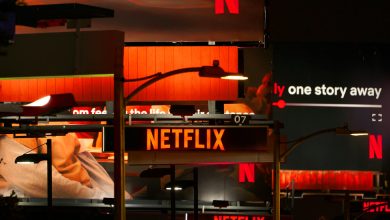Biden’s Curious Talking Point: Lower Deficits Offer Inflation Relief

As Americans deal with the highest inflation in decades, President Biden has declared that combating rising costs is a priority for his administration. Lately, he has cited one policy in particular as an inflation-fighting tool: shrinking the nation’s budget deficit.
“Bringing down the deficit is one way to ease inflationary pressures in an economy,” Mr. Biden said this month. “We reduce federal borrowing and we help combat inflation.”
The federal budget deficit — the gap between what the government spends and the tax revenue it takes in — remains large. But Mr. Biden has pointed out that it shrank by $350 billion during his first year in office and is expected to fall more than $1 trillion by October, the end of this federal budget year.
Rather than stemming from any recent budget measures by his administration or Congress, the deficit reduction largely reflects the rise in tax receipts from strong economic growth and the winding down of pandemic-era emergency programs, like expanded unemployment insurance. And for many experts, that — plus the reality that deficits have a complicated relationship with inflation — makes the budget gap a surprising talking point.
“It’s probably not something they should be taking credit for,” Dan White, director of government consulting and fiscal policy research at Moody’s Analytics, said of the Biden team’s emphasis on deficit reduction. The expiration of the programs is mostly “not making things worse,” he said.
The Biden administration’s March 2021 spending package helped the economic rebound, but it also meant the deficit shrank less than it otherwise would have last year. In fact, the $1.9 trillion relief plan probably added to inflation, because it pumped money into the economy when the labor market was starting to heal and businesses were reopening.
But the White House has explained its new emphasis on deficit reduction and fiscal moderation in terms of timing. Administration officials argue that back in March 2021, the world was uncertain, vaccines were only beginning to roll out and spending heavily on support programs was an insurance policy. Now, as the labor market is booming and consumer demand remains high, the administration says it wants to avoid ramping up spending in ways that could feed further inflation.
“Supply chains have created challenges in ramping up production as quickly as we were able to support demand,” said Heather Boushey, a member of the White House Council of Economic Advisers. “The point he’s trying to make is that the plan, moving forward, is responsible and is not aimed at adding to demand.”
Moody’s Analytics estimates that inflation will be about a percentage point lower this year than it would be had the government continued spending at last year’s levels.
But few people, if anyone, expected those programs to continue. And while it is possible to make a rough estimate about how much fading fiscal support is helping with the inflation situation, as Moody’s did, a range of economists have said that it is hard to know how much it matters for inflation with precision.
Understand Inflation and How It Impacts You
- Inflation 101: What is inflation, why is it up and whom does it hurt? Our guide explains it all.
- Inflation Calculator: How you experience inflation can vary greatly depending on your spending habits. Answer these seven questions to estimate your personal inflation rate.
- Interest Rates: As it seeks to curb inflation, the Federal Reserve began raising interest rates for the first time since 2018. Here is what that means for inflation.
- State Intervention: As inflation stays high, lawmakers across the country are turning to tax cuts to ease the pain, but the measures could make things worse.
- How Americans Feel: We asked 2,200 people where they’ve noticed inflation. Many mentioned basic necessities, like food and gas.
The tie between budget deficits and inflation is also more complex than Mr. Biden’s statements suggest.
Deficits, which are financed by government borrowing, are not inherently inflationary: Whether they push up prices hinges on the economic environment as well as the nature of the spending or cutback in revenue that created the budget shortfall.
Policies that reduce the deficit could be inflationary, for instance. A big, broadly distributed stimulus that gives direct cash aid to low- and middle-income households could be more than offset in a budget by revenue from large tax increases on the wealthy. But shuffling much of that money to people who are likely to spend it quickly could cause demand to outstrip supply, leading to inflation. Alternatively, spending that would enlarge deficits — like debt-financed investments in energy infrastructure — could reduce inflation over time if the program improves efficiency, expands capacity or makes production cheaper.
“I’ll fall back on the typical economist answer and say: It depends,” said Andrew Patterson, a senior international economist at Vanguard.
The last time the federal government had a budget surplus was 2001. Since 1970, there have only been four years in which the U.S. government taxed more than it spent. Over that period, there have been times of both high and low inflation.
“There’s no simple-minded deficit-to-inflation link — you have to look at both the demand and the supply side of the economy,” said Glenn Hubbard, a professor of finance and economics at Columbia University who headed the Council of Economic Advisers under President George W. Bush. The existence or absence of high inflation has more to do with imbalances in the real economy than with complex budget math. “If aggregate demand grows much faster than aggregate supply, you will see inflation,” he said.
Complicating matters in the current situation, the stimulus from the last couple of years is still trickling out into the economy because consumers have amassed savings stockpiles that they are spending down, and because state and local governments continue to use untapped relief funds.
And stimulus-stoked demand is far from the only reason prices are rising. Over the past year, because of factory shutdowns and overburdened transit routes, companies have struggled to expand supply to meet booming demand. Shortages of cars, couches and construction materials and raw components have helped to push costs higher.
Recent global developments are worsening the situation. The Chinese government’s latest lockdowns to contain the coronavirus threaten to shake up factory production and shipping, while the war in Ukraine has caused fuel and food prices to increase.
Employers are also raising wages as they scramble to hire in a hot job market, and that increase in labor costs is prompting some companies to raise prices to protect their profit levels. Some companies are even increasing their profits, having discovered that they can charge more in an era of hot demand.
The demand drag from fading pandemic relief doesn’t appear to have been large enough to substantially offset those other forces. To date, price gains for a range of goods and services have mostly accelerated.
Inflation F.A.Q.
What is inflation? Inflation is a loss of purchasing power over time, meaning your dollar will not go as far tomorrow as it did today. It is typically expressed as the annual change in prices for everyday goods and services such as food, furniture, apparel, transportation and toys.
What causes inflation? It can be the result of rising consumer demand. But inflation can also rise and fall based on developments that have little to do with economic conditions, such as limited oil production and supply chain problems.
Is inflation bad? It depends on the circumstances. Fast price increases spell trouble, but moderate price gains can lead to higher wages and job growth.
How does inflation affect the poor? Inflation can be especially hard to shoulder for poor households because they spend a bigger chunk of their budgets on necessities like food, housing and gas.
Can inflation affect the stock market? Rapid inflation typically spells trouble for stocks. Financial assets in general have historically fared badly during inflation booms, while tangible assets like houses have held their value better.
Consumer prices rose 8.3 percent in the year through April 2022, just slightly below a March high that was the fastest rate of increase since 1981. A closely watched inflation measure that excludes volatile food and fuel costs actually picked up in April from the previous month, a sign that price pressures remain strong.
What happens next with inflation is likely to depend on the response from the Federal Reserve. The central bank is raising interest rates to make borrowing money more expensive, a move that could help supply catch up with overall demand in the economy, allowing price increases to moderate.
But that process is likely to be an unpleasant one that could rankle markets, push unemployment higher and even cause a recession.
Given that glum backdrop, the White House — while acknowledging that the Fed is primarily in charge of managing inflation — has also been emphasizing that it is doing what it can to help Americans who are struggling to afford groceries, housing and transportation.
The administration has rolled out some specific price-reduction measures — including the release of oil from the Strategic Petroleum Reserve in a bid to lower the cost of gas and working to improve the domestic supply of semiconductors to alleviate a shortage. But many of these efforts are either short-term moves or changes that will take a long time to provide meaningful relief.
“They do seem intent on at least looking like they are finding ways to address inflation,” said Sarah Binder, a political scientist at George Washington University. Still, she said, she found the administration’s new focus on the deficit unusual.
“In some ways it’s a little surprising: Most voters aren’t paying all that much attention to the deficit,” Ms. Binder said. Polling from Gallup shows that 17 percent of Americans say inflation is the top problem facing the nation, while 1 percent cite the deficit.
Regardless, the government may struggle to keep the deficit shrinking in the coming years. Bipartisan agreements to substantially raise taxes or reduce some forms of spending have proved elusive. Pandemic spending programs have largely lapsed, so their expiration won’t have as much impact onthe deficit in the future, and large government obligations such as Social Security payments are still set to increase over time.
The Congressional Budget Office expects the deficit to begin increasing again in 2025 in dollar terms, and it may increase again as a share of gross domestic product in 2026.
Recently, the president has promoted another idea for fighting inflation: “Make sure the wealthiest corporations pay their fair share.” Since his 2020 campaign, he has pushed to raise the corporate tax rate to 28 percent from 21 percent.
Some researchers say that while such changes might help to alleviate inflation at the margin, tweaks in taxing and spending should not be the first line of defense against a sudden rise in prices.
“Fiscal policy shouldn’t be your main inflation-fighting tool,” said Louise Sheiner, policy director for the Hutchins Center on Fiscal and Monetary Policy at the Brookings Institution. “On inflation, it’s mostly up to the Fed.”




